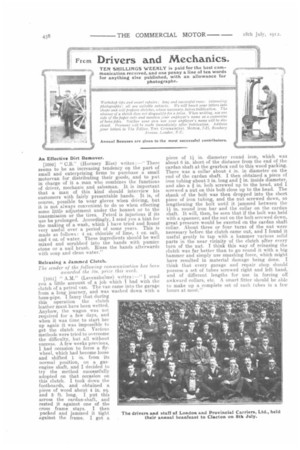Frcm Drivers and Mechanics.
Page 20

If you've noticed an error in this article please click here to report it so we can fix it.
TEN SHILLINGS WEEKLY is paid for the best corn. munication received, and one penny a line of ten words for anything else published, with an allowance for photographs.
Workshop tips and smart rePairs : long and successful FMCS: interesting Photographs ; all are suitable subjects. We will knock your letters into shak and will prepare sketches, where necessary, before Publication. ne absence of a sketch does not disqualify/ova prize. When imiting, use one side of the paper only and mention your employer's name as a guarantee
of bona fides, .Vet/her your own nor your employer's name be dis closed. Payment be made immediately after publication. Address
Annual Bonuses are given to the most successTul contributors. Avenue, London, E.C.
An Effective Dirt Remover.
[1080] " C.B." (Hornsey Rise) writes :—" There seems to be an increasing tendency on the part of small and enterprising firms to purchase a small motorvan for distributing their goods, and to put in charge of it a man who combines the functions of driver, mechanic and salesman. It is important that a man of this kind should interview his customers with fairly presentable hands. It is, of course, possible to wear gloves when driving, but it is not always convenient to do so when effecting some little adjustment under the bonnet or to the transmission or the tires. Petrol is injurious if its use be prolonged. Accordingly, I send you a hint for the making of a wash, which I have tried and found very useful over a period of some years. This is made as follows : 4 oz. chloride of lime, .1 oz. salt, and 4 oz. of water. These ingredients should be well mixed and scrubbed into the hands with pumice stone or a nail brush. Rinse the hands afterwards with soap and clean water."
Releasing a Jammed Clutch.
The sender of the following communication. has been awarded the Ws. prize this week.
[1081] " A.M." (Levenshulme) writes:—' I send you a little account of a job which 1 had with the clutch of a petrol van. The van came into the garage from a long journey, and was washed down with a hose-pipe. I fancy that during this operation the clutch leather must have been wetted. Anyhow, the wagon was not required for a few days, and when it was time to start her up again it was impossible to get the clutch out. Various methods were tried to overcome the difficulty, but all without success. A few weeks previous, I had occasion to force a flywheel, which had become loose and shifted 1 in. from its normal position, on a gasengine shaft, and I decided to try the method successfully adopted on that occasion on this clutch. I took down the footboards, and obtained a piece of wood about 4 in. sq. and 5 ft long. I put this across the cardan-shaft, and rested it against one of the cross frame stays. I then packed and jammed it tight against the frame. I got a piece of 14 in. diameter round iron, which was about 6 in. short of the distance from the end of the cardan shaft at the gearbox end to this wood packing. There was a collar about 4 in. in diameter on the end of the cardan shaft. I then obtained a piece of iron tubing about 3 in. long and I in. inside diameter, and also a 4 in. bolt screwed up to the head, and I screwed a nut on this bolt close up to the head. The shank of the bolt was then dropped into the short piece of iron tubing, and the nut screwed down, so lengthening the bolt until it jammed between the 14 in. round iron bar and the collar on the cardan shaft. It will, then, be seen that if the bolt was held with a spanner, and the nut on the bolt screwed down, great pressure would be exerted on the cardan shaft collar. About three or four turns of the nut were necessary before the clutch came out, and I found it useful gently to tap with a hammer various solid parts in the near vicinity of the clutch after every turn of the nut. I think this way of releasing the clutch was far better than to o round it with a big hammer and simply use smashing force, which might have resulted in material damage being done. I think that every garage and repair shop should possess a set of tubes screwed right and left hand, and of different lengths for use in forcing off awkward collars, etc. A smart fitter should be able to make up a complete set of such tubes in a few hours at most."






















